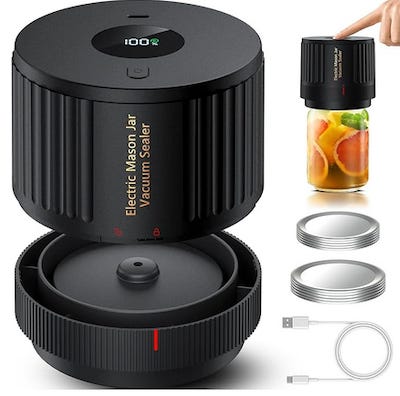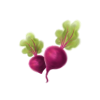Stop Microplastics At Your Kitchen Door
Easy ways to make your daily tasks and habits healthier
There’s a “problem” with awareness. Maybe you’ve experienced this too.
You learn something new, and then - you can’t unlearn it. It affects everything you do. And to be honest, sometimes it drives you a little crazy.
Enter microplastics. New studies say they’re everywhere. What was once the little darlings of human advancement is now one of the biggest problems in our present times.
Microplastics are linked to so many health problems: cardiovascular disease, reproductive disorders, cancer, obesity, metabolic disorders, and neurological disorders.
But here’s the thing - there’s no escaping it. A recent study found the average adult consumes approximately 2,000 microplastics per year just through salt.
It’s in the air we breathe, the water we drink, the soil that grows our foods. Put simply, we can’t avoid it.
As a nutrition coach, that’s a big concern. And yes, at times it seems so exhausting keeping up with the latest news. When I first learned about it, it stopped me for a moment. Now, just when I’ve made one change, several more come to light.
Why can’t “they” just do what’s right for human health?
Alas, that’s not going to happen anytime soon. It took years to ban red dye No. 3 from foods, even though authorities have known it’s a potential cancer risk for 35 years. (And even with all that knowledge, the ban in December 2024 won’t affect the food we eat until January 2027 … two years to eliminate it!)
Of course, as consumers, we can take the path of not buying or consuming anything with red dye No. 3, but it does take work to ensure it’s not in what you buy. 😞
And this leads me back to microplastics. I know microplastics are harmful. I know they’re in everything around me. Here are the upgrades I’m working on this year to make my world a little cleaner. (In case you’re ready to make changes too!)
Hi! I’m looking to grow my followers this year. If you want to read more about plant-based living, I’m ready to share. I dip into all sides of plant-based, giving you recipes, sharing kitchen tips, providing nutritional education, and educating you on the food industry. I’d love it if you follow me, and I’d love to hear from you too!
Eliminating Plastics From Food and Drink Containers
Let’s start with a video I recently watched. Another reminder of what we’re dealing with.
Ready to change?
Plastic has been a part of my kitchen forever. I got my first set of plastic storage as a shower gift when I got married. And that cupboard has seen ebb and flow ever since. I’ve tried replacing it with glass, without a lot of success. Glass chips and breaks, so I circulate them in and out quickly.
Recently, I added a nifty little device to my kitchen. It’s a mason jar vacuum sealer, and it works really well. Charge it up. Then, fill a mason jar. I’ve been playing with what I put inside:
Berries
Salad
Leftovers
Herbs
Grains
Place the lid on top, push the sealer on, and press the button. Forty seconds later, the lid is sealed and you can store it in your fridge or pantry. This isn’t a canner - it isn’t for the long-term. But it’s amazing at keeping whatever you put inside fresher, longer. I brought home a pint of blueberries from the store and placed them inside. Testing it out, I left them there for two weeks, and they looked like I’d just picked them up at the market.
I’m excited to use this for my summer travels. We love picnicking at summer concerts, traveling to the coast, or just finding any place to spend more time outside. I love the idea of packing up fruits and salads for our lunch or dinner and having them fresh when we arrive.
And maybe this is the one way I’ll be able to eliminate plastic food storage forever.
Filtering My Drinking Water
I’m still working through this, as I haven't found the perfect solution for our lifestyle.
Two things impact my decision.
We rent, so I can’t make large, permanent modifications to my water supply.
I use my kitchen A LOT, so consistently filling up a water reserve tank sounds like a bigger problem than I want to take on.
Still, I know filtering my drinking water is probably one of the most important changes I can make for my health. It’s the best way to get rid of microplastics, and all the other contaminants that might be lurking inside.
I suggest starting with EWG’s Tap Water Database. When I find my local water source, it tells me this:
What I like about EWG’s database is that it provides the latest results for your area, and shows you what can help you remove contaminants from your water supply. (Our water district doesn’t add fluoride … yeah!)
Keep in mind, there is never a perfect choice. Reverse osmosis is a popular way to take a lot of the bad stuff out of the water, but you’ll also have to remineralize the water to add back the healthy minerals you need. (Calcium and magnesium are the two biggest.)
Choices, choices, choices. A little search leads to so many different systems:
Berkey
Aquasana
New Wave Enviro
APEX
AQUATru
It also leads to a whole lot of confusion. Who certifies them? What warranties do they offer? Do they really work?
This is just some of what I’m looking at and considering. I know this one small change is vital to my health, and even a small change can add up over time. Have you invested in a water filtration system yet? I’d be interested in hearing your thoughts.
Look At How You Make Tea and Coffee
Did you know those tiny little tea bags contain microplastics? One study showed that steeping a single plastic tea bag at brewing temperature can release up to 11.6 billion microplastics and 3.1 billion nanoplastics into a single cup. Ugh!
I love tea, and drink it every morning. Tea bags are convenient. They’re super easy to buy. They’re super easy to use. But when I think of billions of microplastics floating around in every cup, it’s a big turnoff.
How to live life and stay safe too? That’s the question. So I went hunting for a solution.
Start with tea bags - not every brand uses them in their tea bag production. You’ll have to do your research, and keep researching periodically, but a recent search led me to these:
My husband has used a French coffee press for his morning coffee for several years after having a problem with mold in the standard coffee pot he used. He LOVES his French coffee press, and has always had a ton of good things to say about it.
When I started seeing French tea presses before Christmas, a lightbulb moment occurred. Could I still enjoy my love of tea, and find a new way to brew it?
I’ve tried teapots with infusers. I’ve used a wide variety of loose leaf tea brewers for both pots and individual cups. They aren’t as convenient as tea bags, which may be why I still reach for them when I rise at 5 am on the weekdays.
Only time will tell how much use I get from a French tea press, but I do really like the idea.
No Tour Is Complete Without Talking About The Extras
Glance around your kitchen. The amount of plastic can be a bit terrifying.
I’m not talking about cleaning out your entire kitchen and replacing it in one swoop. That would be timely, costly, and just way too difficult. So I’ve turned to replacing things one at a time, the things I use most frequently.
Like cutting boards. One study found that cutting carrots on a plastic board can generate as much as 15 milligrams of microplastics per cut. Scary …
Or plastic utensils. They’re made from plastics that can have a variety of chemicals (like decaBDE and microplastics) in them that leach into food.
These are easy to ditch.
Here’s what I’ve found. Go with hardwood instead of softwood. Maple offers natural antibacterial properties, cherry is good for durability. Walnut offers durability and resistance to moisture for long-lasting results, while beech wood provides exceptional strength and sustainable practicality. Here are a few things I’m considering and investing in:
I recommend sticking with brand names you can research, backed with warranties and companies that offer customer service. Because wood can also come with a variety of chemicals and pesticides, I only use wood from manufacturers I can trust.
Research is everything.
That’s what I’m doing this year to make my kitchen just a bit more healthy. How about you?
p.s. Did you like this message? It would mean a lot to me if you’d press the ❤️ below if you liked it, left a comment 💬, or shared it with a friend. I’m trying to grow this publication, and I depend on people like you to do so!
And if you’re new here, Welcome! 💐 I’d love to start sharing my message with you if you’re interested in all things plant-powered, proaging, or finding kitchen joy. Subscribe … and then explore my entire archive! Glad to share with you! 🙋🏼♀️













